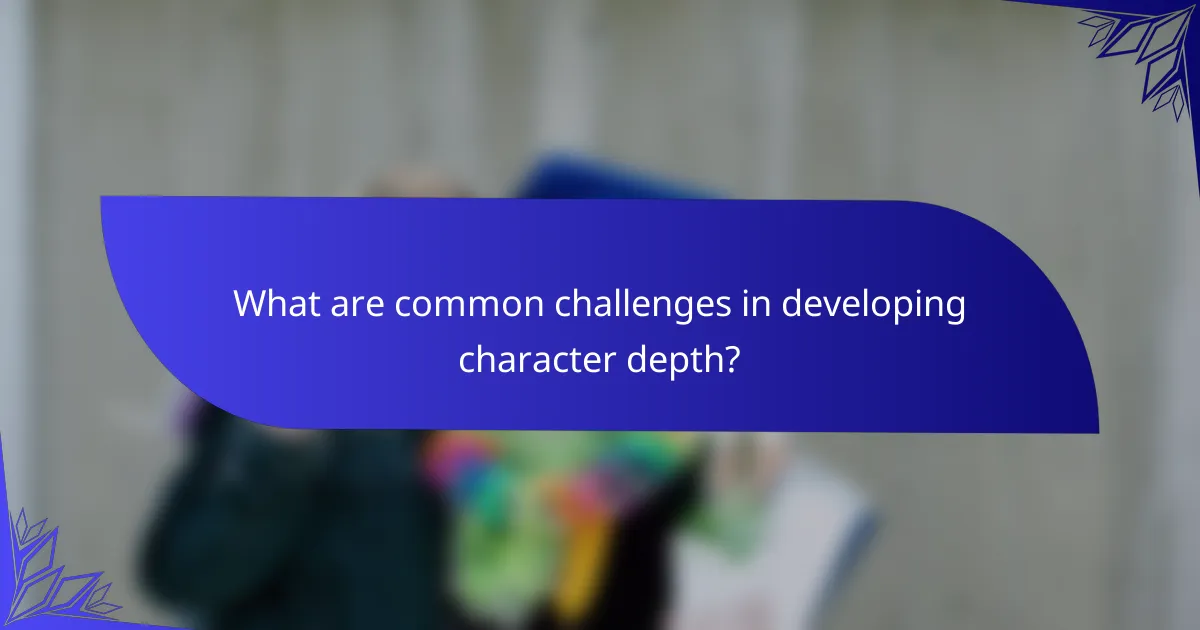The article focuses on directing approaches for developing character depth in film and theater. Key techniques discussed include character backstory exploration, emotional arc mapping, and actor collaboration, which enhance actors’ understanding of their roles and motivations. Additionally, the article highlights the importance of nuanced dialogue and visual storytelling in creating multi-dimensional characters that resonate with audiences. Common challenges such as lack of backstory, inconsistent traits, and superficial motivations are also addressed, emphasizing the need for careful planning to achieve effective character development. Overall, the article provides a comprehensive overview of strategies to ensure authentic and engaging character portrayals.

What are Directing Approaches for Developing Character Depth?
Directing approaches for developing character depth include techniques such as character backstory exploration, emotional arc mapping, and actor collaboration. Character backstory exploration involves creating detailed histories for characters. This helps actors understand motivations and relationships. Emotional arc mapping outlines the character’s emotional journey throughout the narrative. It ensures consistency and growth in character portrayal. Actor collaboration encourages open dialogue between directors and actors. This fosters a shared vision and allows for deeper character interpretation. These approaches are supported by studies in performance psychology, which emphasize the importance of understanding character motivations for authentic portrayals.
How do directing approaches influence character development?
Directing approaches significantly influence character development by shaping how actors interpret and embody their roles. Different directing styles, such as method acting or classical techniques, impact the depth of character portrayal. Method acting encourages actors to draw on personal experiences, fostering authentic emotional responses. In contrast, classical techniques may emphasize physicality and external traits, shaping characters through visual storytelling. Research shows that directors who prioritize collaboration create a more dynamic character development process. For example, directors like Stanislavski emphasized actor engagement, resulting in nuanced performances. Thus, the directing approach directly affects the complexity and relatability of characters in a production.
What are the key elements of character depth in directing?
Key elements of character depth in directing include backstory, motivation, and emotional complexity. Backstory provides context for a character’s actions and decisions. It helps the audience understand the character’s history and influences. Motivation drives a character’s choices and behaviors throughout the narrative. Clear motivations allow for relatable and believable characters. Emotional complexity involves a range of feelings and reactions. This depth makes characters more realistic and engaging. Directors often use these elements to enhance storytelling and audience connection. Research shows that well-developed characters lead to greater viewer investment in narratives.
How can directors assess character depth in their work?
Directors can assess character depth by analyzing the character’s backstory, motivations, and relationships. They should evaluate how these elements influence the character’s actions and decisions. Observing the character’s emotional range is also crucial. Directors can use script analysis to identify key moments that reveal depth. Engaging with actors through discussions can provide insights into character interpretation. Additionally, feedback from test audiences can highlight how well the character resonates. Research shows that multi-dimensional characters enhance viewer engagement and storytelling effectiveness.
Why is character depth important in storytelling?
Character depth is important in storytelling because it enhances emotional engagement and relatability. Deeply developed characters resonate with audiences, allowing them to form connections. Such connections lead to a more immersive experience. Research indicates that audiences are more likely to remember stories with complex characters. Characters with depth often display realistic motivations and conflicts. This realism fosters empathy and understanding in the audience. As a result, stories become more impactful and memorable.
What impact does character depth have on audience engagement?
Character depth significantly enhances audience engagement. Deeply developed characters evoke emotional connections. Audiences relate to complex motivations and struggles. This relatability fosters investment in the story. Research indicates that well-rounded characters increase viewer retention. A study by the University of Southern California found that audiences prefer narratives with multi-dimensional characters. Engaging characters lead to discussions and social sharing. This interaction amplifies the overall impact of the narrative.
How does character depth contribute to narrative complexity?
Character depth enhances narrative complexity by creating multi-dimensional characters. These characters exhibit a range of emotions, motivations, and conflicts. This complexity allows for richer storytelling. It enables deeper audience engagement and investment in the plot. When characters face intricate dilemmas, the narrative becomes more compelling. For example, a character with a troubled past may struggle with trust, influencing their decisions. This layered characterization leads to unpredictable plot developments. Studies show that narratives with complex characters are more memorable and impactful.

What techniques can directors use to enhance character depth?
Directors can enhance character depth through techniques such as backstory development, nuanced dialogue, and visual storytelling. Backstory development involves creating detailed histories for characters, which informs their motivations and decisions. Nuanced dialogue allows characters to express complex emotions and relationships, revealing their inner conflicts. Visual storytelling employs cinematography and framing to convey character emotions and themes without words. These techniques collectively create multi-dimensional characters that resonate with audiences. For instance, films like “The Godfather” use backstory and dialogue to explore character motivations, adding layers to the narrative.
How can improvisation be utilized in character development?
Improvisation can be utilized in character development by allowing actors to explore their characters in real-time. This technique encourages spontaneity and authenticity in performances. Through improvisation, actors can discover unique traits and emotional responses that may not emerge in scripted scenes. It fosters deeper connections between characters and their motivations. Research shows that improvisational exercises enhance creativity and adaptability in actors. A study by Johnstone (1981) highlights how improvisation can lead to richer character portrayals. By engaging in improvisational activities, actors gain a better understanding of their characters’ backgrounds and relationships. This method ultimately contributes to a more nuanced and believable performance.
What are the benefits of improvisation for actors and directors?
Improvisation benefits actors and directors by enhancing creativity and spontaneity. It allows actors to explore their characters more deeply. This exploration leads to more authentic performances. Directors benefit from improvisation by gaining insights into character dynamics. It fosters collaboration between actors and directors. Improvisation also improves adaptability during performances. Studies show that improvisation can increase confidence in actors. This confidence translates to better on-stage presence and audience engagement.
How can directors facilitate effective improvisation sessions?
Directors can facilitate effective improvisation sessions by creating a safe and supportive environment. This encourages actors to take risks and express themselves freely. Establishing clear objectives for the session helps focus the improvisation. Providing specific prompts or scenarios can guide the actors’ creativity. Encouraging collaboration among actors fosters a sense of teamwork. Offering constructive feedback during and after the session enhances learning and development. Maintaining flexibility allows for unexpected ideas to emerge. Lastly, scheduling regular improvisation sessions builds confidence and skill over time.
What role does backstory play in developing character depth?
Backstory plays a crucial role in developing character depth. It provides context for a character’s motivations and behaviors. This context helps audiences understand why characters make certain choices. A well-crafted backstory enriches character relationships and interactions. It can reveal vulnerabilities and strengths that shape the character’s journey. For example, a character with a traumatic past may display resilience or fear in challenging situations. Research indicates that characters with detailed backstories are often more relatable and engaging to audiences. This engagement enhances emotional investment in the story.
How can directors create compelling backstories for their characters?
Directors can create compelling backstories for their characters by deeply understanding their motivations and histories. This involves researching the character’s background and experiences. Directors should consider the character’s relationships, pivotal life events, and personal struggles. Utilizing character questionnaires can help outline these aspects. Engaging with actors during rehearsals can provide insights into how the backstory influences performance. Additionally, incorporating visual storytelling elements can enhance the emotional depth of the character’s history. For instance, flashbacks or visual motifs can effectively convey backstory. Ultimately, a well-crafted backstory enriches the character and engages the audience.
What techniques help reveal backstory effectively on screen?
Flashbacks are a common technique to reveal backstory effectively on screen. They provide viewers with visual context about a character’s past. This technique allows for a direct glimpse into formative experiences. Voiceovers can also convey internal thoughts and memories. This method adds depth by explaining motivations and emotions. Dialogue can subtly reveal backstory through character interactions. Characters may reference past events in conversations. Visual storytelling through props or settings can hint at backstory. For instance, a character’s belongings may reflect their history. These techniques collectively enhance character development and audience engagement.

What are common challenges in developing character depth?
Common challenges in developing character depth include lack of backstory, inconsistent traits, and superficial motivations. A well-developed character requires a rich history that informs their actions. Without this, characters may seem flat or unrealistic. Inconsistencies in traits can confuse the audience and weaken character believability. Superficial motivations fail to engage viewers, making characters less relatable. Additionally, balancing complexity with clarity can be difficult. Overly complex characters may lose audience connection. Conversely, overly simplistic characters lack engagement. Therefore, effective character depth requires careful planning and execution.
What pitfalls should directors avoid when creating characters?
Directors should avoid creating one-dimensional characters. One-dimensional characters lack depth and relatability. This can lead to disengagement from the audience. Directors must ensure characters have clear motivations and backgrounds. Failing to do so can result in clichéd or stereotypical portrayals. Additionally, directors should avoid inconsistent character development. Inconsistency can confuse viewers and undermine the narrative. It’s crucial for directors to avoid neglecting character arcs. A well-developed arc allows for growth and transformation. Lastly, directors should steer clear of overly complex characters without clear purpose. Complexity must serve the story and not detract from it.
How can stereotypes undermine character depth?
Stereotypes can undermine character depth by reducing complex individuals to simplistic traits. This oversimplification limits the audience’s understanding of the character’s motivations and experiences. Characters defined by stereotypes often lack unique attributes, making them less relatable. For example, a character portrayed solely as a “dumb jock” misses opportunities for emotional growth or intelligence. Research shows that stereotype-driven portrayals can lead to audience disengagement. A study by the American Psychological Association highlights that characters lacking depth can reinforce negative stereotypes. This results in a cycle where audiences expect and accept shallow representations. Ultimately, reliance on stereotypes hinders the development of multi-dimensional characters.
What strategies can directors employ to avoid cliché characters?
Directors can avoid cliché characters by developing unique backstories for each character. This strategy creates depth and individuality. Engaging in character interviews helps directors understand motivations and desires. Directors should also encourage actors to bring personal experiences into their performances. Incorporating unexpected traits can further differentiate characters from stereotypes. Utilizing diverse casting promotes varied perspectives and authenticity. Collaborating with writers on nuanced scripts minimizes reliance on familiar tropes. Lastly, directors can analyze successful films and identify what makes characters memorable, applying those insights to their own work.
How can directors ensure authenticity in character portrayal?
Directors can ensure authenticity in character portrayal by conducting thorough character research. This involves understanding the character’s background, motivations, and emotional landscape. Engaging with actors in collaborative discussions can help bring depth to the character. Directors should encourage actors to explore their characters’ emotional truths. Utilizing improvisation can also reveal authentic reactions. Observing real-life individuals who share similarities with the character can provide insights. Directors can implement feedback sessions to refine performances. According to a study by the American Psychological Association, authentic portrayals enhance audience connection and engagement.
What methods promote genuine performances from actors?
Methods that promote genuine performances from actors include method acting, improvisation, and emotional recall techniques. Method acting encourages actors to immerse themselves in their characters’ experiences. This approach often leads to authentic emotional responses. Improvisation allows actors to explore spontaneity and creativity. It can result in more natural interactions on stage or screen. Emotional recall techniques help actors connect personal experiences to their characters’ emotions. This connection fosters a deeper portrayal of feelings. Studies show that these methods can enhance the believability of performances. For instance, research by Lee Strasberg highlights the effectiveness of method acting in creating realistic portrayals.
How can feedback loops enhance character authenticity?
Feedback loops can enhance character authenticity by providing continuous input on character development. These loops allow creators to gather insights from audiences or collaborators regarding character actions and motivations. By integrating this feedback, creators can adjust character traits to better resonate with viewers. This process fosters a deeper connection between the audience and the character. Research shows that characters perceived as authentic lead to increased viewer engagement. For instance, a study by Cohen and Harrison (2014) found that relatable characters enhance emotional investment in narratives. Therefore, feedback loops are essential for refining character authenticity through iterative improvement.
What best practices can directors follow for developing character depth?
Directors can develop character depth by focusing on comprehensive character backstories. A well-defined backstory informs motivations and behaviors. Directors should collaborate closely with actors to explore emotional nuances. This collaboration fosters authenticity in performances. Additionally, directors can utilize detailed character arcs throughout the narrative. Character arcs illustrate growth and change, enhancing relatability. Incorporating subtext in dialogue adds layers to character interactions. Subtext reveals underlying emotions and intentions. Finally, directors should encourage improvisation to uncover spontaneous character traits. This approach can lead to unexpected, genuine moments that enrich character portrayal.
How can collaborative workshops improve character depth?
Collaborative workshops can improve character depth by facilitating diverse perspectives and ideas. These workshops bring together writers, actors, and directors to brainstorm and develop characters. This exchange of viewpoints leads to richer character backgrounds and motivations. Participants can challenge each other’s assumptions, resulting in more nuanced portrayals. Research shows that collaboration enhances creativity, as evidenced by studies on group dynamics in creative processes. The varied input from different individuals can uncover unique traits and conflicts within characters. This process ultimately creates more relatable and complex characters that resonate with audiences.
What resources are available for directors to refine their approach?
Directors can access various resources to refine their approach. These include workshops that focus on character development techniques. Books on directing and character analysis provide in-depth insights. Online courses are available to enhance specific skills related to directing. Peer feedback from fellow directors can offer valuable perspectives. Additionally, mentorship programs connect emerging directors with experienced professionals. Industry seminars and conferences present opportunities to learn from experts. Film analysis and critique can help directors understand character depth in existing works. These resources collectively support directors in enhancing their craft.
Directing approaches for developing character depth encompass techniques such as character backstory exploration, emotional arc mapping, and actor collaboration. These methods influence character portrayal by shaping actors’ interpretations and enhancing emotional engagement. Key elements include backstory, motivation, and emotional complexity, which contribute to the relatability and authenticity of characters. Additionally, directors can utilize improvisation and collaborative workshops to refine character depth, while also avoiding common pitfalls like clichés and stereotypes. Ultimately, these strategies aim to create multi-dimensional characters that resonate with audiences and elevate narrative complexity.